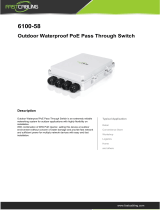
Dell PowerConnect W-IAP175 Outdoor Instant Access Point | Installation Guide 11
Antenna Position and Orientation
Once the required antenna height has been determined, other factors affecting the precise position of the wireless
bridge or mesh link must be considered:
Be sure there are no other radio antennas within 2 m (6 ft) of the wireless bridge or mesh link. These include
other WiFi radio antennas.
Place the wireless bridge or mesh link away from power and telephone lines.
Avoid placing the wireless bridge or mesh link too close to any metallic reflective surfaces, such as roof-
installed air-conditioning equipment, tinted windows, wire fences, or water pipes. Ensure that there is at least
5 feet clearance from such objects.
The wireless bridge or mesh link antennas at both ends of the link must be positioned with the same
polarization direction, either horizontal or vertical. Proper alignment helps to maximize throughput.
Radio Interference
The avoidance of radio interference is an important part of wireless link planning. Interference is caused by other
radio transmissions using the same or an adjacent channel frequency. You should first scan your proposed site
using a spectrum analyzer to determine if there are any strong radio signals using the 802.11a/b/g channel
frequencies. Always use a channel frequency that is furthest away from another signal.
If radio interference is still a problem with your wireless bridge or mesh link, changing the antenna direction may
improve the situation.
Weather Conditions
When planning wireless bridge or mesh links, you must take into account any extreme weather conditions that
are known to affect your location. Consider these factors:
Temperature: The wireless bridge or mesh link is tested for normal operation in temperatures from -30ºC to
55ºC. Operating in temperatures outside of this range may cause the unit to fail.
Wind Velocity: The wireless bridge or mesh link can operate in winds up to 165 miles per hour. You must
consider the known maximum wind velocity and direction at the site and be sure that any supporting
structure, such as a pole, mast, or tower, is built to withstand this force.
Lightning: To protect against lightning induced surges, the W-IAP175 requires lightning protection on the
radio interface ports.
Rain: The wireless bridge or mesh link is weatherproofed against rain. However, it is recommended to apply
weatherproof sealing tape around the ethernet port and antenna connectors for extra protection. If moisture
enters a connector, it may cause a degradation in performance or even a complete failure of the link.
Snow and Ice: Falling snow, like rain, has no significant effect on the radio signal. However, a buildup of snow
or ice on antennas may cause the link to fail. In this case, the snow or ice has to be cleared from the antennas
to restore operation of the link.
Ethernet Cabling
When a suitable antenna location has been determined, you must plan a cable route from the wireless bridge or
mesh link outdoors to a suitable power and/or network source.
Consider these points:
The ethernet cable length should never be longer than 90 m (295 ft).
Determine a building entry point for the cable (if applicable).
CAUTION: A Dell Lightning Arrestor, AP-LAR-1, must be installed on each antenna port for protection against lightning induced
surges. Failure to use an AP-LAR-1 can void the warranty of an Dell outdoor AP model and renders the AP susceptible to failure
from lightning induced surges





















